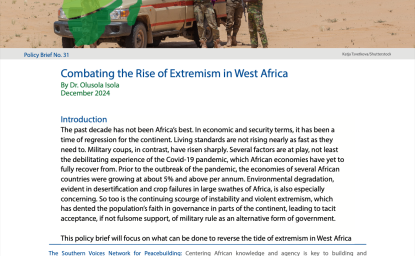North Africa's Jihadis
In this interview, Fellow Alex Thurston discusses jihadism in North Africa.
In this interview, Fellow Alex Thurston discusses jihadism in North Africa.
In the following interview, Alex Thurston, a fellow at the Woodrow Wilson Center, discusses jihadism in North Africa.
Even before the Islamic State broke away from al Qaeda, North Africa was a significant source of recruits for the group, especially among Libyans, Tunisians, and Moroccans, who headed to Syria and Iraq as fighters. Beginning in 2014, when the Islamic State started creating “provinces” outside of Iraq and Syria, North Africa also became a major theater of operations. The Islamic State created four initial provinces there: one, in Algeria, proved weak, and Wilayat Fazzan (southern Libya) also proved more or less notional. But other holdings in Libya were quite important. From the fall of 2014 through the summer of 2015, the Islamic State exercised significant control in the eastern coastal city of Derna (Wilayat Barqa). From early 2015 through the fall of 2016, the Islamic State also had control over major areas of Sirte, a centrally located coastal city (Wilayat Tarabulus).
As the Islamic State lost territory in Syria and Iraq, in 2015 and 2016, there was widespread speculation that Libya might be a fallback for its leadership. Several factors weighed against this scenario, however. One was simple geography. “Libya’s open spaces and its intensely contested landscape leave little room for the Islamic State,” a report in the Combating Terrorism Center at West Point explained. After the Islamic State’s losses in Derna and Sirte, some fighters did seek a new start in remote areas. But as of April 2018, the group had not taken control of any other major city. Meanwhile, several commanders were killed in Libya, including Iraqi and Saudi leaders originally sent from the ISIS caliphate to head the Libyan affiliate (one was Iraqi national Abu Nabil al Anbari, killed in eastern Libya in November 2015 in a U.S. airstrike). By the end of 2017, the group’s losses in Iraq and Syria paralleled similar losses in North Africa, especially in Libya.
#IS suicide attack failed near #Libya's #Sirte#Abu_Grein #ISIShttps://t.co/CgQBgLnJdn pic.twitter.com/fVXl4o5NLK
— Libyan Express (@libyanexpress) January 11, 2018
Historically, Libya was a significant source of foreign fighters for three jihadist movements: the campaign against the Soviet occupation of Afghanistan in the 1980s; the jihadist mobilization against U.S. forces and the Shiite-dominated government in Iraq; and the first three years of the Syrian civil war that erupted in 2011. But many Libyans in Syria started returning home in spring 2014. They provided the nucleus of the Islamic State’s affiliate in Derna.
Around 800 of the estimated 3,000 Tunisians who joined the jihad in Syria and Iraq returned home, according to a Soufan Group report in October 2017. Estimates are far lower for Morocco (fewer than 200 returnees) and Algeria (fewer than 100 returnees). Figures for Libya are not available. Some data comes from government sources that are hard to verify, however.
It’s too simplistic to say that the Islamic State focuses on seeking territory and brooking little compromise, while al Qaeda has adapted to local environments by building popular support and jihadist networks for the long-term. Al Qaeda’s efforts to localize have sometimes diluted the jihadist project. Some connections between al Qaeda and local jihadists or jihadist-leaning militias have been so indirect and tenuous that they are not really part of al Qaeda.
Al Qaeda’s brand suffers from at least two other problems. First, some local jihadists find the brand so toxic that they don’t want to be associated with it. Second, opportunists use and then discard the brand as it suits them — or hurl the label at others when that tactic is advantageous. In 2014, an American journalist visiting southern Libya noted, “The problem was that everyone called everyone else Al Qaeda — if the organization wanted to file for copyright infringement, Ubari would be the place to start.”
In North Africa, the differences between the Islamic State and al Qaeda can sometimes blur, especially at the operational and tactical level. Both groups periodically carry out high-profile terrorist attacks. Both have been involved in experiments to take and hold territory. And both have sought to become entrenched through local alliances.
At the level of creed, the Islamic State is often more willing to impose its own theological dictates and less willing to compromise, but that doesn’t mean the Islamic State never compromises. In Sirte, for example, its ranks included former elements of Moammar Qaddafi’s regime in blatant contradiction to its opposition to Arab regimes. Al Qaeda is more simply open about its willingness to compromise.
Another difference is that many Islamic State fighters are either younger North Africans or leaders sent to North Africa by the Islamic State’s central leadership. In contrast, many of al Qaeda’s leaders and allies in North Africa tend to be older veterans of the jihadist scene, including people with experience fighting in the 1990s.
The 2014-2016 period stands out as one of significant violence. It witnessed both high-profile attacks – the Bardo Museum attack of March 2015 and the Sousse resort attack of June 2015, both in Tunisia, as well as territorial conquests in Libya. Since 2016, jihadist violence has not ended in North Africa but it has diminished. In July 2017, for example, Britain downgraded its travel warning for Tunisia; it urged travelers to exercise significant caution but removed its advice against all but essential travel. It cited security improvements and a lack of major attacks targeting Westerners in Tunisia since the 2015 incidents.
Tunisia beach attack: Killer Seifeddine Rezgui 'trained in Libya' with Bardo Museum gunmen http://t.co/gN94UFivBF pic.twitter.com/WCFo88a2jM
— IBTimes UK (@IBTimesUK) June 30, 2015
In Morocco and Algeria, meanwhile, relative security prevails. There are ongoing concerns about the impact of returning fighters, especially in Morocco. But so far the worst-case scenarios have not materialized. The biggest problem remains in Libya, although it revolves more around political instability and widespread militia activity than just jihadism. Among neighbors to the south, the trendlines are quite bad, with Mali and its neighbors, particularly Burkina Faso and Niger, experiencing substantial jihadist violence.
The larger and more successful the franchise, the more that the Islamic State central leadership seems to want to control it. This has been evident in ISIS’ different attitudes toward Libya and Algeria. In fall 2014, ISIS proclaimed the existence of affiliates in both places. But its Algerian affiliate, Jund al Khilafa, was mostly dismantled by Algerian authorities in fall 2014, and ISIS’ central leadership largely ignored it after the initial pledge of allegiance. In contrast, ISIS’ affiliate in Libya proved considerably stronger, and ISIS sent major leaders, such as Iraqi Abu Nabil al Anbari (mentioned above) to direct its activities. After the Islamic State’s Libya holdings collapsed in the second half of 2016, the central leadership seemed to cut back support and attention for the Libyan affiliate as well. An issue of the Islamic State’s Arabic-language newsletter Al Naba in early 2018 contained no story on Libya. The remnants of the Islamic State in Libya may have significant independence as of April 2018.
Alex Thurston, a 2017-2018 Wilson Center fellow, is Assistant Professor of Teaching in the African Studies Program at Georgetown University's School of Foreign Service. His current book project is "Jihadism and Local Politics: Cases from North Africa and the Sahel."


Learn more about Hamas and how it relates to similarly aligned organizations throughout the region. Read more


